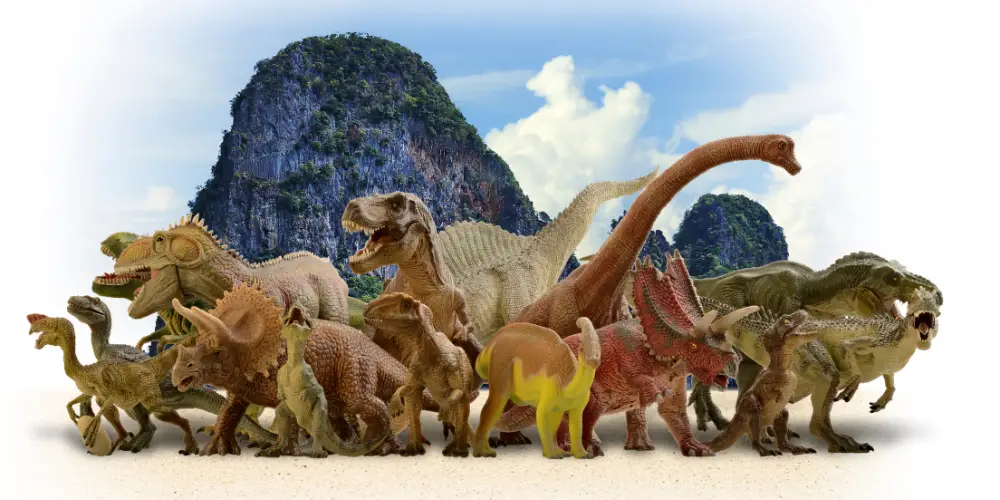Has there ever been a moment when you wondered, “Are dinosaurs real?” Isn’t the concept of towering reptilian beasts roaming the earth just mind-boggling? The public’s fascination with these prehistoric titans is undeniable and for a good reason.
But what do science, history, and even religious texts have to say about the existence of these incredible creatures?
Dinosaurs are real, evidenced by extensive fossil records and ongoing paleontological research. The Bible doesn’t explicitly mention dinosaurs but alludes to ‘great sea monsters,’ possibly encompassing dinosaurs, and suggests their existence may have been before or overlapped with early humans.
Prepare yourself for a thrilling exploration into the world of dinosaurs – their history, the proof of their existence, popular myths, their portrayal in pop culture, and their impact on our planet.
Key Take Aways
- Dinosaurs are real, proven by extensive fossil evidence and paleontological studies.
- The study of dinosaurs began in the 19th century, with the term coined by Sir Richard Owen in 1842.
- Advancements in technology have reshaped our understanding of dinosaurs, revealing many as warm-blooded and feathered.
- Myths about dinosaurs co-existing with humans have been scientifically debunked.
- Some interpretations suggest the Bible might reference dinosaurs, possibly linking their extinction to Noah’s flood.
- Ongoing research continues to unveil new dinosaur species and insights.
- Dinosaurs are prevalent in pop culture, though often with inaccuracies.
- Dinosaur extinction is attributed to the Chicxulub asteroid impact and Deccan Traps volcanic activity.
- Fascinating facts highlight the vast diversity of dinosaur species, from tiny to colossal.
- Studying dinosaurs offers insights into Earth’s history, mass extinctions, and the importance of preserving ecosystems.
The History of Dinosaur Discovery
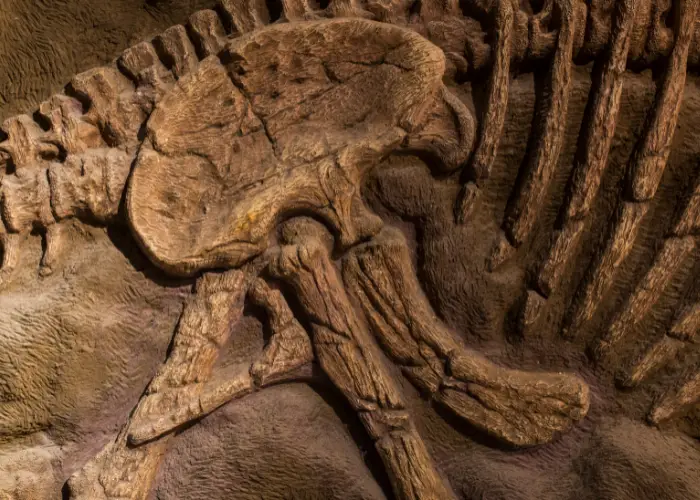
The Dawn of Dinosaur Discovery
Our journey through the history of dinosaur discovery begins in the early 19th century.
Before this period, fossilized dinosaur remains, albeit misidentified, had certainly been discovered.
However, it was not until the 1820s that these findings were recognized as distinct and fundamentally different from the animals of today.
The pioneering figure of dinosaur discovery was an English scientist named Gideon Mantell. In 1822, Mantell stumbled upon unusual teeth and bones in Sussex, England, which he soon identified as remains of a creature he named Iguanodon – the second dinosaur ever named.
However, the first dinosaur to be described scientifically was Megalosaurus, identified by William Buckland in 1824.
The term ‘dinosaur,’ which means ‘terrible lizard,’ was coined later in 1842 by Sir Richard Owen, a British paleontologist, to describe these ‘fearfully great’ reptiles.
Evolution of Dinosaur Understanding
But these early interpretations were rudimentary at best, often based on mere fragments of fossils.
It wasn’t until much later, with the advent of more advanced technology and methodology, that we started to grasp the real scope of these creatures.
The bone-by-bone assembly of dinosaur skeletons helped paleontologists understand their size, structure, and physical capabilities.
The Ongoing Journey of Discovery
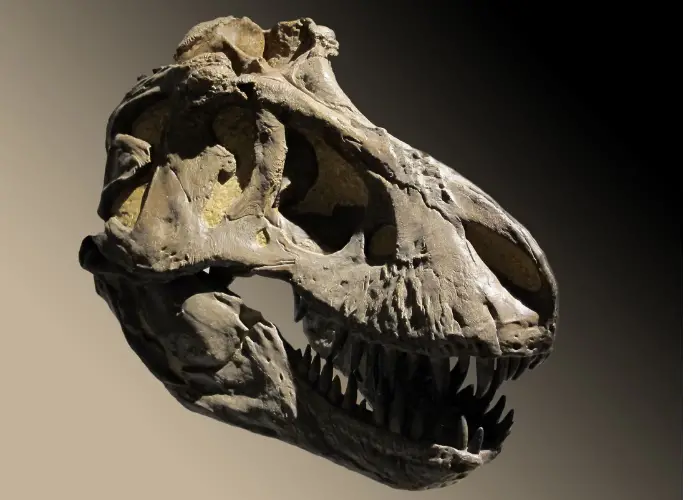
One of the most exciting aspects of paleontology is the ongoing nature of the field. Our understanding of dinosaurs is continually evolving.
For instance, it was long assumed that dinosaurs were slow-moving and cold-blooded, akin to modern reptiles.
However, discoveries in the late 20th century suggested that many dinosaurs were likely warm-blooded and much more active than previously thought.
Moreover, a breakthrough came in the 1990s when paleontologists uncovered evidence of feathers in several dinosaur species, which revolutionized our visual conception of these creatures and solidified the link between dinosaurs and birds.
This discovery was a testament to the transformative power of paleontology, as our preconceived notions about dinosaurs were suddenly upended.
In the 21st century, dinosaur research is still vibrant, with new species being discovered regularly.
Each new finding, whether it’s a dinosaur nest in Mongolia, a well-preserved Ankylosaur in Canada, or a new species like the Titanosaur in Argentina, continues to fill gaps in our understanding and bring us closer to painting a complete picture of the mesmerizing world of dinosaurs.
Proof of Dinosaur Existence
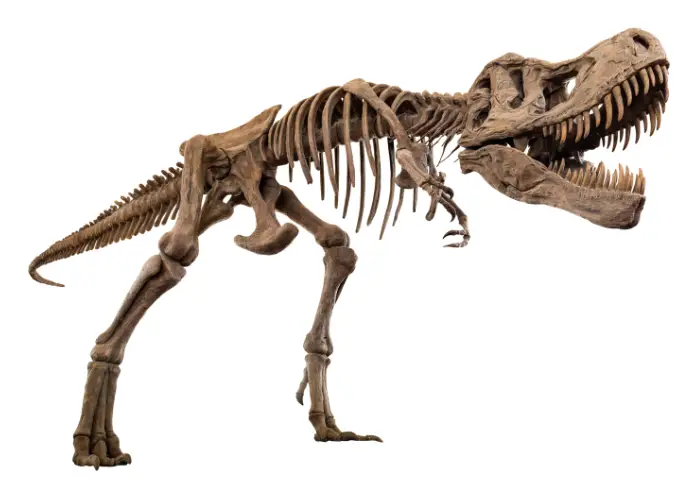
Extensive scientific evidence strongly supports the fascinating reality of dinosaurs that once roamed our Earth. Here, we delve into these solid proofs that make it undeniable that these colossal beings indeed existed:
Fossil Formation
Fossils are the preserved remains, or traces of remains, of ancient organisms, acting as our primary source of evidence for dinosaurs.
The process begins when an animal or plant dies and is rapidly covered by sediments.
As these sediments harden into rock over time, they conserve the organic material, often preserving incredible details like skin texture or a dinosaur’s last meal.
Body Fossils
These include bones, teeth, and claws that give us insight into the physical attributes of various dinosaur species. The form and structure of these fossils reveal critical details like a dinosaur’s size, diet, and movement patterns.
Trace Fossils
Trace fossils like footprints, nests, and even coprolites (fossilized feces) provide invaluable insights into a dinosaur’s behavior and environment. They reveal how a dinosaur moved, whether it traveled in groups, its speed, etc.
Iconic Fossil Finds
Some almost perfectly preserved specimens have been discovered in places like Liaoning, China.
These fossils, often showcasing small, feathered dinosaurs, have challenged traditional images of dinosaurs as purely scaly creatures, painting a picture of fluff-covered beings instead.
“Sue,” the T. rex
The discovery of a near-complete T. rex skeleton named “Sue” in South Dakota, USA, is one of the most compelling pieces of evidence for dinosaurs.
As one of the most extensive and best-preserved T. rex fossils ever found, “Sue” has provided a wealth of information about this iconic species.
Each piece of evidence embedded in the Earth’s crust brings us closer to understanding the awe-inspiring world of dinosaurs.
It’s not just about proving their existence; it’s about painting a vivid picture of a life that was so different from our own yet fundamentally connected.
What The Bible Says About Dinosaurs
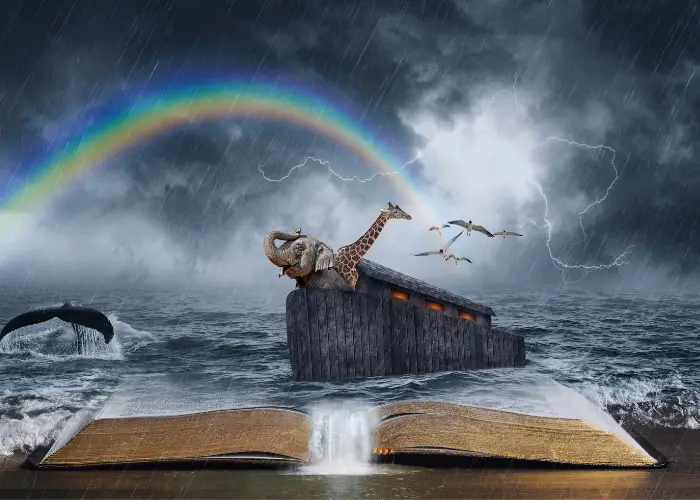
The Bible doesn’t offer detailed accounts of the creation and extinction of dinosaurs.
Genesis mentions that all animals were created during the fifth and sixth ‘days’ or periods.
The term “great sea monsters” [Hebrew, tan·ni·nimʹ] used in this context might encompass dinosaurs, suggesting their creation occurred on the ‘fifth day’. (Gen. 1:21)
However, it remains uncertain if dinosaurs survived until humans were created, which would be towards the end of the sixth ‘day’.
At the very latest, dinosaurs may have become extinct during the flood mentioned in Noah’s story.
Considering dinosaurs were reptiles, and many shared structural similarities with lizards (note that sauros is the Greek word for ‘lizard’), this seems plausible.
Dinosaurs varied significantly in size, and not all were gigantic. Therefore, if any dinosaurs survived until the Flood, it wouldn’t necessitate including the colossal species in Noah’s Ark.
Smaller representatives of the same family or ‘kind’ would have been enough to comply with the divine command. (Gen. 6:19, 20; 7:14)
Several older versions of the Bible occasionally translate the Hebrew term tan·ni·nimʹ as ‘dragons’ instead of ‘sea monsters’ (Ps. 74:13; 148:7; Isa. 27:1, Authorized Version).
The term ‘dragon’ (Greek, draʹkon) appears in the Christian Greek Scriptures, possibly referring to huge creatures like dinosaurs.
This term might have acquired a mythical connotation only after these enormous creatures vanished.
Intriguingly, many depictions of ‘dragons’ in myths resemble some types of dinosaurs, further supporting this theory.
Latest Dinosaur Findings
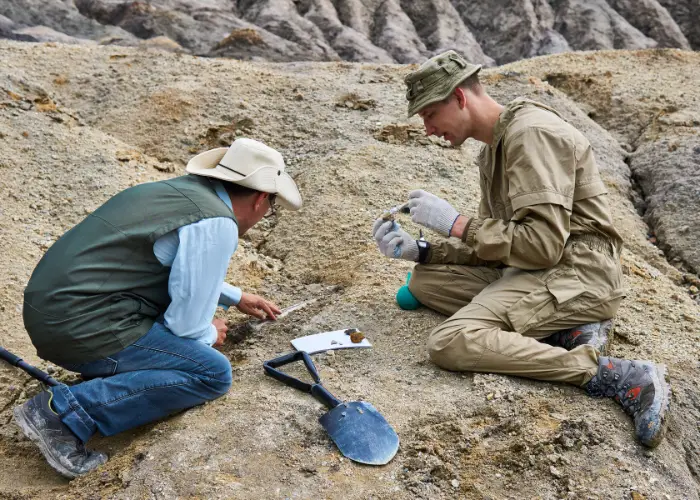
- In June 2023, a new dinosaur species was discovered on the Isle of Wight, off the south coast of England. The dinosaur, named Vectipelta barretti, is the first armored dinosaur to have been found on the island in 142 years
- In May 2023, scientists discovered a new species of spinosaurid in Spain, based on fossil fragments that include a right jaw bone, one tooth, and five vertebrate.
- In June 2023, a new beaked dinosaur species was identified from a 99-million-year-old fossil found in Utah. The dinosaur, dubbed Iani smithi, was about 12 feet from the tip of its snout to the end of its tail.
- In May 2023, a new dinosaur species was identified in Thailand, called Minimocursor phunoiensis. The fossil was described as an “exceptionally articulate skeleton” and one of Southeast Asia’s most well-preserved dinosaurs ever discovered.
Debunking Dinosaur Myths
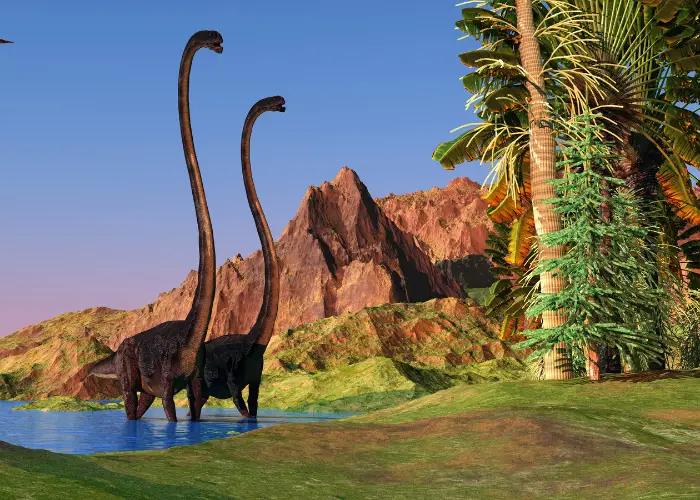
To understand whether dinosaurs were real, we must face a range of myths and misconceptions. Here, we address and debunk some of the most common myths surrounding these ancient creatures:
Myth 1: Dinosaurs are a Hoax
Some skeptics claim that dinosaur fossils are manufactured by scientists or misinterpreted remains of other animals.
This is a clear misconception, as the fossil identification and interpretation process is a rigorous scientific practice validated by numerous independent experts in the field.
Myth 2: Humans and Dinosaurs Coexisted
Popular culture often portrays humans and dinosaurs living together. However, this is far from the truth.
The extinction of dinosaurs occurred approximately 66 million years ago, while the earliest known ancestors of humans didn’t appear until about 6 million years ago.
Myth 3: All Dinosaurs are Gigantic
While the term “dinosaur” might evoke images of towering creatures, many dinosaurs were quite small.
Some were even the size of modern birds or smaller. The wide variety of sizes among dinosaur species is part of what made them so successful and diverse.
Myth 4: Dinosaurs are all Reptiles
Though dinosaurs are a group within the reptiles, not all had typical reptilian characteristics.
Discoveries in the late 20th century showed evidence of feathers in various dinosaur species, linking them more closely to birds than modern reptiles.
Myth 5: Dinosaurs are Extinct
While it’s true that most dinosaur species went extinct 66 million years ago, one group survived and evolved into a very familiar group of animals: birds. So, in a way, dinosaurs continue to live among us.
Myth 6: Dinosaurs were all Cold-Blooded
For a long time, dinosaurs were believed to be cold-blooded like modern reptiles. However, recent studies suggest that at least some dinosaurs were likely warm-blooded, providing them with the energy to hunt actively and grow quickly.
Myth 7: The T-Rex couldn’t run
Recent research has debunked the belief that Tyrannosaurus rex was a slow mover. Detailed biomechanical studies and footprints suggest that this fearsome predator could have speeds that would be fast enough to track down prey.
By debunking these myths, we can appreciate the diversity and richness of the dinosaur era, reinforcing that dinosaurs were indeed real and fascinatingly varied.
Dinosaurs in Pop Culture
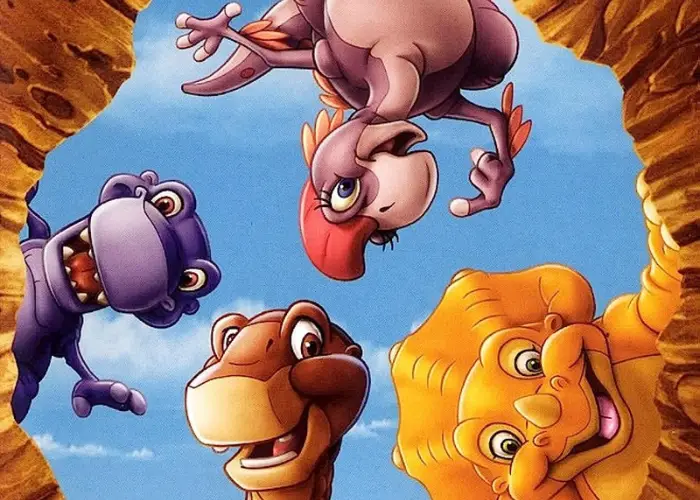
In addition to being real, dinosaurs have found a firm foothold in our collective imagination, largely thanks to their portrayal in pop culture.
Let’s explore how dinosaurs have been represented and how these representations have shaped our understanding and perceptions of these prehistoric giants.
Representation of Dinosaurs in Movies, Books, and Art
Few can forget the awe-inspiring moment in Jurassic Park when the audience first encountered a living, breathing dinosaur on screen.
Since then, dinosaurs have become a staple in movies, books, and art, capturing the fascination of both adults and children alike.
Movies such as ‘The Land Before Time,’ ‘Ice Age’, and the ‘Jurassic Park series, among others, have brought dinosaurs to life with remarkable detail and creativity. (Image credits)
In literature, books like ‘Jurassic Park’ by Michael Crichton and ‘The Lost World’ by Arthur Conan Doyle have thrilled readers with tales of these prehistoric beasts.
Moreover, countless artworks, ranging from scientific illustrations to children’s cartoons, depict dinosaurs in myriad ways.
How Pop Culture Shapes Our Perception of Dinosaurs
The influence of pop culture on our perceptions of dinosaurs cannot be overstated. These representations often form our first exposure to dinosaurs, shaping how we imagine these creatures looked and behaved.
While they can inspire curiosity and foster a love for paleontology, they can also lead to misconceptions.
For example, the cinematic depiction of Velociraptors as human-sized predators is far from the truth, as they were the size of a turkey.
The Importance of Scientific Accuracy in Dinosaur Representations
While creative liberties are often taken in pop culture portrayals of dinosaurs, scientific accuracy is essential to foster an informed understanding of these creatures.
Advances in paleontology continually reshape our knowledge of dinosaurs, and this evolving understanding should be reflected in our representations of them.
Scientists and artists often collaborate in this endeavor, creating accurate yet captivating depictions of dinosaurs.
It’s a thrilling experience to see a dinosaur ‘come to life’ on a cinema screen or within the pages of a book.
By emphasizing scientific accuracy in these portrayals, we can ensure that our fascination with dinosaurs is matched by a proper understanding of these magnificent creatures that once roamed our planet.
The Impact of Dinosaur Extinction
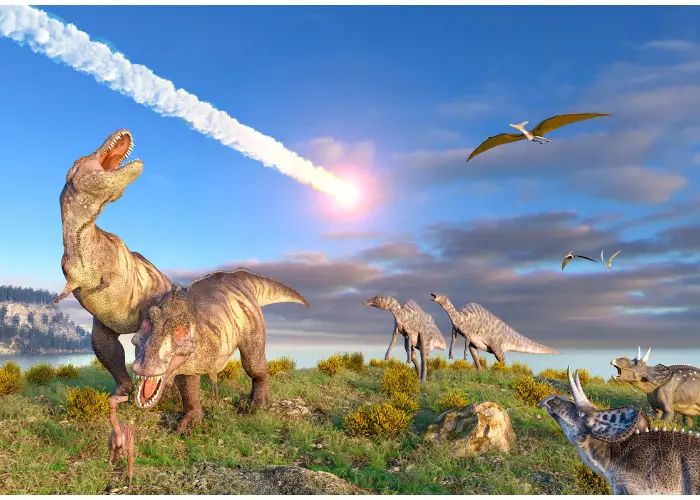
Theories Behind the Extinction of Dinosaurs
The Asteroid Impact Theory
According to the most popular theory, a cataclysmic event involving a massive asteroid or comet striking the Earth caused drastic environmental changes that led to mass extinction.
This event, known as the Chicxulub impact, occurred in the region now known as the Yucatan Peninsula.
The resulting shockwaves, wildfires, tsunamis, and the subsequent “impact winter” caused by dust and debris blocking sunlight.
It likely disrupted habitats and food chains to the point where survival became impossible for many species, including dinosaurs.
The Volcanic Activity Theory
Another significant theory posits that long-term volcanic activity, particularly in the Deccan Traps (modern-day India), played a crucial role in the extinction of dinosaurs.
The massive sulfur and carbon dioxide released during these eruptions could have led to severe climate change involving global cooling, warming, and acid rain.
Such changes would have devastated plant life, creating a domino effect of extinction among herbivores and subsequently, the carnivores that preyed on them.
A Combination of Catastrophic Events
Importantly, these theories are not mutually exclusive, and it’s plausible that a combination of these factors, along with other environmental changes such as sea level fluctuations and continental drift, contributed to the dinosaurs’ extinction.
The convergence of these catastrophic events likely created a lethal environment, eventually wiping out the dinosaurs.
Importance of Studying Dinosaur Extinction

Understanding the reasons behind the extinction of dinosaurs isn’t just a matter of historical interest. It holds significant implications for our present and future as well.
By studying these massive global shifts, we learn more about the Earth’s climate system and how it responds to sudden drastic changes.
This knowledge can inform our understanding of present-day climate change and guide us in predicting future environmental shifts.
Moreover, studying extinction events helps us understand patterns of biodiversity.
The mass extinction that wiped out the dinosaurs also led to the rise of mammals, setting the stage for human evolution. Understanding these patterns can explain the potential impact of current and future extinctions.
Lastly, the story of dinosaurs serves as a stark reminder of the fragility of life. Despite their dominance, dinosaurs were unable to adapt to rapid environmental changes.
This awareness underscores the importance of sustainable living and the necessity to mitigate our environmental impact to prevent another mass extinction.
Fun Facts About Dinosaurs

Diving into the world of dinosaurs, we can unearth a treasure trove of intriguing and fun facts about these prehistoric creatures. Here are a few that might surprise you:
- The smallest dinosaur: The smallest dinosaur known to scientists is the Bee Hummingbird. Yes, you read that right! Modern birds are technically considered dinosaurs, and this tiny bird, measuring just 5 cm long, is today’s smallest dinosaur. However, of the extinct dinosaurs, the smallest was probably the Compsognathus, about the size of a chicken.
- The largest dinosaur: Arguably, the largest dinosaur – and indeed the largest land animal ever – was Argentinosaurus, a long-necked, long-tailed dinosaur from Argentina, which measured up to 35 meters in length and may have weighed between 80 and 100 tons.
- The dinosaur with the longest name: Micropachycephalosaurus, meaning ‘tiny thick-headed lizard,’ holds the record for the dinosaur with the longest name.
- Speedy dinosaurs: The fastest dinosaurs were probably ostrich-like dinosaurs such as the Dromiceiomimus, which could run up to 60 km/h.
- Dinosaur brain power: Contrary to popular belief, not all dinosaurs had a small brain compared to body size. Troodontids, small, bird-like dinosaurs, are considered the smartest, with a brain-to-body ratio similar to modern birds.
Just think about it: dinosaurs ranged from tiny hummingbirds to massive, long-necked giants.
They included swift runners, slow lumberers, tiny-brained creatures, and intelligent hunters. With such diversity and adaptability, dinosaurs dominated the Earth for over 160 million years.
So, next time you wonder, “are dinosaurs real,” you can confidently answer “yes” and share some cool dinosaur facts to amaze your friends!
Final Thoughts

Returning to our time, we carry a sense of wonder and knowledge about these magnificent creatures who once roamed our Earth.
From our first exploration into the realm of dinosaur discovery, understanding their origins, size, and lifestyle, to the undeniable fossil proofs of their existence, we’ve seen that dinosaurs were real.
We’ve dispelled common myths, illuminating the facts and fiction surrounding these ancient beings.
We’ve also acknowledged their influence in pop culture, shaping our imagination and perspectives over the years.
Dinosaurs, though extinct, still hold a significant place in our understanding of life on Earth.
Their abrupt disappearance provides critical insight into our planet’s delicate balance, reminding us of preserving biodiversity and maintaining ecological harmony.
Studying dinosaurs also teaches us about Earth’s deep history, our position, and how life evolves and adapts over millions of years.
The wonder and curiosity they inspire in us also fuel scientific discovery and innovation, leading to advancements in biology, geology, and paleontology.
So, to all the dinosaur lovers out there, let’s continue this thrilling journey of discovery.
Keep asking questions, keep exploring, and keep learning.
Remember, every new piece of knowledge brings us one step closer to understanding these fantastic prehistoric creatures and our place in this vast, interconnected web of life.
Here’s to you, fellow explorers!
Let’s keep the spirit of adventure and discovery alive!
FAQs
Do Dinosaur Eggs Still Exist?
Yes, dinosaur eggs do still exist, but only in fossil form. Over time, these eggs have been mineralized and preserved, providing valuable insight into dinosaurs’ nesting habits, growth, and development.
Is it Possible to Bring Back Dinosaurs?
As of current knowledge and technology, bringing back dinosaurs is impossible. While genetic engineering advancements have been made, reconstructing a complete, viable dinosaur genome from fossils remains a significant challenge.
Would Humans Survive if Dinosaurs Came Back?
This is speculative, but if dinosaurs were to come back, it would dramatically change our ecosystem. Coexistence would depend on numerous variables including the types of dinosaurs, their numbers, and how both humans and dinosaurs adapt.
REFERENCES:
- Questions From Readers — Watchtower ONLINE LIBRARY. (n.d.). Wol.jw.org. Retrieved July 28, 2023, from https://wol.jw.org/en/wol/d/r1/lp-e/1973528
- Dinosaur. (2023, July 26). In Wikipedia. https://en.wikipedia.org/wiki/Dinosaur
- de Santisteban, C., Poza, B., & Meseguer, S. (2023). A new spinosaurid dinosaur species from the Early Cretaceous of Cinctorres (Spain). Scientific Reports, 13(1), 1-13. https://doi.org/10.1038/s41598-023-33418-2
- Cretaceous Research. (n.d.). Elsevier. Retrieved July 29, 2023, from https://www.journals.elsevier.com/cretaceous-research
- Journal of Vertebrate Paleontology. (n.d.). Taylor & Francis. Retrieved July 29, 2023, from https://www.tandfonline.com/toc/ujvp20/current
- Palaeontologia Electronica. (n.d.). Coquina Press. Retrieved July 29, 2023, from https://palaeo-electronica.org/
- PaleoBios. (n.d.). University of California Museum of Paleontology. Retrieved July 29, 2023, from https://ucmp.berkeley.edu/science/paleobios/


